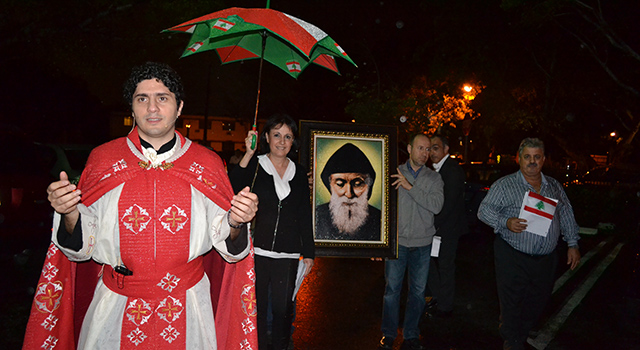By Priscilla A. Greear - Florida Catholic
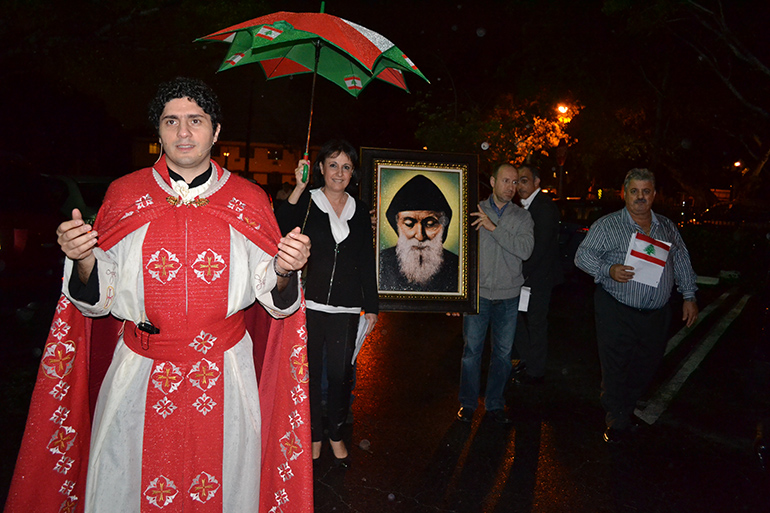
Photographer: MONICA LAUZURIQUE | FC
Father Elie Saade, pastor of Our Lady of Lebanon Maronite Catholic Church, processes in the rain to welcome the relic of St. Sharbel, accompanied by his parishioners.
CORAL GABLES | On the 22nd of every month, around 20,000 pilgrims walk in procession from the hermitage where St. Sharbel lived, through the mountains of Lebanon, to the Annaya monastery where he was buried � evidence of how the 19th century monk remains a lodestar of holiness for Middle Eastern Christians.
In that same reverent spirit, around 1,000 people poured into Our Lady of Lebanon Maronite Church on Coral Way on the rainy evening of Feb. 6 to venerate his relic � a bone fragment � for the 24-hour period it visited there during its tour of the United States.
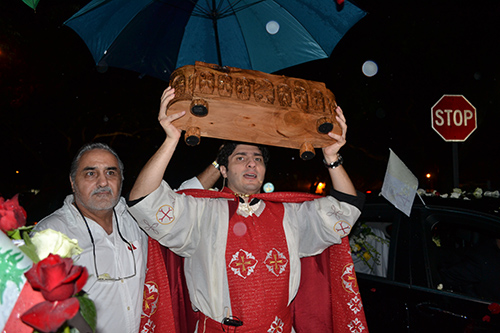
Photographer: MONICA LAUZURIQUE | FC
With umbrellas shielding him from the rain, Father Elie Saade carries the relic of St. Sharbel in procession around the parking lot of Our Lady of Lebanon Maronite Catholic Church, where the faithful venerated it for 24 hours, Feb. 6-7.
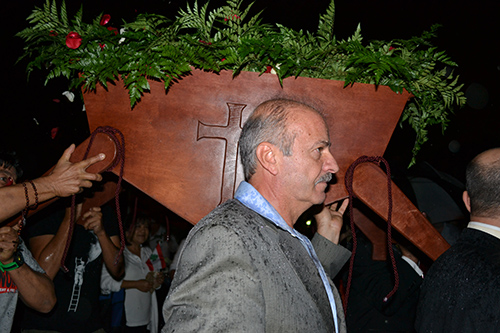
Photographer: MONICA LAUZURIQUE | FC
Parishioners brave the rain to carry the relic of St. Sharbel, now placed in a special carrier, around the parking lot of Our Lady of Lebanon Maronite Catholic Church.

Photographer: MONICA LAUZURIQUE | FC
Our Lady of Lebanon parishioners jam into the church to welcome the relic of St. Sharbel.
Our Lady of Lebanon’s pastor, Father Elie Saade, is the only priest serving in the United States from St. Sharbel’s Lebanese Maronite Order, which arranged for the relic to visit some of the roughly 110 Lebanese Maronite churches in America.
“I can call St. Sharbel my brother. I’ve lived in his monastery as part of my education so that’s why it’s very special for me,” Father Saade said. “The life of St. Sharbel reminds me of the importance of prayer and meditation even in my ministry as a parish priest. It reminds me that eucharistic adoration is the food for our soul that allows us to go into the world and share the Good News.”
The saint is a symbol of hope in the country of 6.1 million that is 40 percent Christian amidst the regional suffering of Christians and bloodshed across the border in Syria.
“Even the Muslims in Lebanon they tell us you are lucky you have St. Sharbel. I think without St. Sharbel there wouldn’t be Christians in the Middle East, especially I’m talking about Lebanon,” said the polyglot priest, who is fluent in French, English, Spanish and Arabic.
“He gives us a lot of strength and you see the miracle that he does, medical miracles and miracles on another level, miracles that heal people who are sick and change their lives,” Father Saade continued.
“In Lebanon church attendance among the youth is much higher than the old people so St. Sharbel is attracting the youth,” he added, noting that every 22nd of the month, “whether it’s snowy or rainy,” more than 20,000 people walk the four-mile procession from the hermitage of St. Sharbel to the monastery.
Similar devotion was evident at Our Lady of Lebanon. Congregants overflowed from the church into the vestibule and parking lot for the celebration of a Mass in Spanish and Aramaic. Afterward, the priest received the relic and members carried it in a wooden reliquary through the parking lot, their procession shortened by a rain shower.
The reliquary was then set on a table before the altar, a space adorned with scarlet and cream roses and graced by statues of St. Sharbel and St. Jude. A second Mass followed in English, Arabic and Aramaic with soulful music including a traditional Maronite Syriac hymn on the son of Lebanon.
In his homily, Father Saade said St. Sharbel was born in 1823 and lived a pious life as a hermit, marked by prayer, silence, worship and labor in the fields, for 23 years. He died in 1898 as he raised the Eucharist during Mass on Dec. 24.
In 1925 his case for canonization was opened and his body was found to be uncorrupted, after which the tomb was sealed. In 1950 monks and neighbors began to see a gleaming light every night from his tomb and he was reported to appear to the monastic superiors. An official committee and certified doctors opened the tomb and found the body uncorrupted and the presence of water and blood.
Miracles began to flow forth and today there’s a room in the monastery filled with letters about healings, abandoned wheelchairs and other belongings from pilgrims.
“They took the blood from the tomb to the lab and found the blood was blood of a living person,” Father Saade said. “All of this is documented, no hearsay. Pope Paul VI declared him blessed in 1977.”
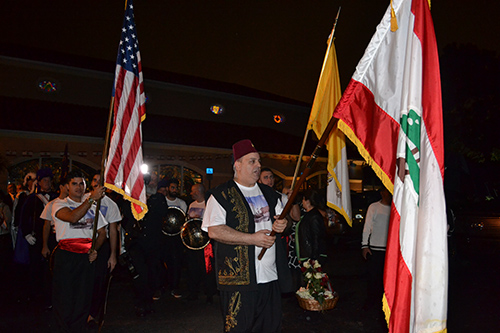
Photographer: MONICA LAUZURIQUE | FC
Parishioners of Our Lady of Lebanon hold Lebanese, American and Vatican flags while waiting for the relic to St. Sharbel to arrive.
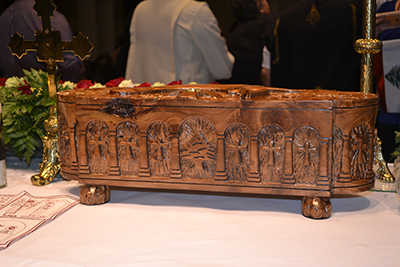
Photographer: MONICA LAUZURIQUE | FC
The reliquary with a bone fragment of St. Sharbel rests on the altar of Our Lady of Lebanon Maronite Catholic Church, where the faithful venerated it for a 24-hour period, Feb. 6-7.
The priest said St. Sharbel teaches the importance of obedience, humility and the Eucharist. While some question the monastic life, he said the holy soul accomplished “more than thousands of priests in the world.”
“He’s coming to us to tell us the way he lived his life, that’s the way of sacrifice,” said Father Saade, also director of Star of the East Maronite online radio. “He died before finishing the Mass and I will finish it for him� If we do not receive the Eucharist, if we do not come to church, we can’t be Christian.”
Later, congregants watched a movie in Spanish on the saint’s life while feasting on kibble and grape leaves in the parish hall decorated with Lebanese flags.
Victoria Read helped prepare for the relic visit.
“I’m from the Dominican Republic and there’s a huge influx of Lebanese people in the Dominican Republic,” she said. “It’s a blessing to have him here. In one of his most recent miracles in Arizona he just cured a blind woman, something that was just recognized by the pope. When my grandfather was sick I prayed to him a lot. He’s very miraculous.”
William Barimo, whose parents were from Aleppo, Syria, visited Lebanon a few years ago and is mindful of the suffering in his devastated ancestral land as well as Lebanon, now flooded with refugees.
“In the Middle East and Lebanon and Syria � there’s a lot of suffering because of the uprising and war. I’ve had many relatives had to leave because of the persecution and fighting going on in Syria.”
Lebanese native Nabil Salem, a founding member of the Knights of Columbus St. Sharbel Council, has had a devotion to the saint since age five, when he was struck by a rock in the head and nearly died. After emergency surgery his mother took him to the monastery for prayer where he experienced healing.
“The doctors said I probably wouldn’t pass 18. This is the experience I’ve had with St. Sharbel. I’m still here,” said Salem, who carries a cloth relic in his wallet. “I’ve got a great devotion to St. Sharbel. It’s like I talk to him like a real person. I think he’s protecting me as well as other people.”
Grace Haddad, born in Venezuela of Lebanese parents, also affirmed his power to inspire.
“Many know him for his miracles, they admire him. I love him because he’s really a hero. When you have someone you want to be like, when you feel like asking something to Jesus, you ask through him. He’s really going to help,” she said.
“I’ve really never experienced so many people here,” she added, referring to the multitude that came to see the saint’s relic.
Our Lady of Lebanon’s 450 families include native and second and third generation Lebanese from the United States and Latin America � along with those simply drawn to the Oriental liturgy in Aramaic.
It’s been a lively new year for the parish, which also just hosted around 4,500 people for its 39th annual Lebanese Festival.
Father Saade also announced at the end of the Mass that the church has commissioned a six-foot statue of St. Sharbel to be sculptured in Lebanon of native stone. It will be placed in front of the church to commemorate the visit.
“In two months we hope to have the biggest statue of St. Sharbel in the United States,” Father Saade said.
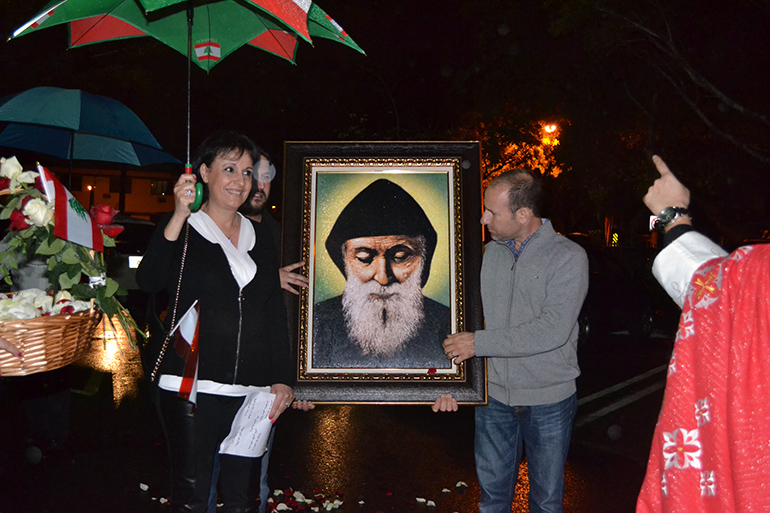
Photographer: MONICA LAUZURIQUE | FC
Carrying an image of St. Sharbel, Our Lady of Lebanon parishioners process in the rain to welcome the Lebanese saint's relic.
